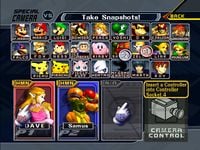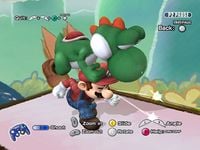Camera
All 3D video games have virtual cameras which follow the action, including the Super Smash Bros. series. During a match, the camera zooms to show all characters - on large stages such as Temple, 75 m and New Pork City, this can cause the camera to zoom out excessively.
Special Melee and Brawl modes exist with slightly altered camera physics, allowing the camera to be locked in place or tilted at an angle.
Still pictures
In Super Smash Bros. Melee
Camera Mode is a special vs. mode in which still pictures can be taken during an endless match with unlimited lives using the Smash Cam. The pictures can be of fighters, items, backgrounds, or any combination. As long as it is on the screen, photographs can be recorded. Each photo takes up some data on the memory card.
Control
Players 1 through 3 can be either computer controlled or human controlled, while Player 4's controller is used to control the camera. Anyone can pause and quit, but only Player 4's pause can be used to take pictures.
Items and Stages
Items can be set to any normal battle settings, with set variations on choices and frequency of appearance. Stages are chosen as normal, save that there is no time limit.
Camera Functions
The joystick is used to move the camera around and pressing L or R cycles through close-ups of the three fighters, centering the camera on them and following their movements. The C-stick pivots the camera around a central pivoting point. If L or R was used to select a character to follow, the pivoting point is on the selected fighter. Zooming is done by pressing X or Y button and dollying is controlled by the D-pad.
The actual "shutter" is the Z button. This can be used with or without pausing. If pausing first, Player 4 can use L and R to choose a fighter, then pivot, zoom in and out, and dolly around until the desired scene is achieved. After the picture it taken, there is the option of saving it or discarding it.
Photos taken are saved onto the memory card. If a memory card is in slot B, it will be saved there. Otherwise, it will be saved onto Slot A's card. Photos range from around 4 to 12 "blocks" of memory, increments used for GameCube memory cards. The average photo takes up around 7 or 8 blocks.
In Super Smash Bros. Brawl
In Super Smash Bros. Brawl, snapshots can be taken at any time from the pause screen, as opposed to only in Camera Mode in Melee. Camera Mode does not make an appearance in Brawl, as it has been rendered obsolete due to the ability to take pictures at any time. Snapshots can also be taken in the Subspace Emissary. Snapshots cannot be taken in stadium mode except in the Boss Battles Mode.
However, when viewing replays, the camera can be more freely controlled, similar to camera mode from Melee, to focus in on characters rotate and, if the user's television set is at 4:3 aspect ratio, crop to widescreen.
Snapshots can be saved onto SD cards, or onto the Wii itself, as opposed to the special GameCube memory cards for Melee. These snapshots can be sent to friends and shared.

